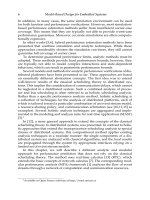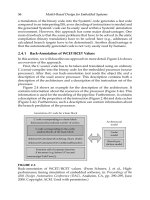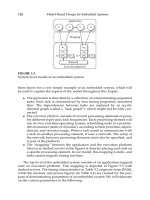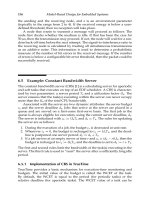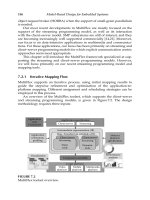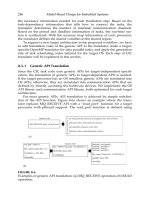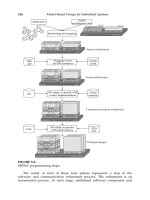Model-Based Design for Embedded Systems- P20 pdf
Bạn đang xem bản rút gọn của tài liệu. Xem và tải ngay bản đầy đủ của tài liệu tại đây (558.26 KB, 10 trang )
Nicolescu/Model-Based Design for Embedded Systems 67842_C006 Finals Page 166 2009-10-1
166 Model-Based Design for Embedded Systems
The Lund RBbot is a dual-drive unicycle robot. It is modeled as a third-
order system
˙
p
x
=
1
2
(R
1
ω
1
+R
2
ω
2
) cos(θ)
˙
p
y
=
1
2
(R
1
ω
1
+R
2
ω
2
) sin(θ)
˙
θ =
1
D
(R
2
ω
2
−R
1
ω
1
)
(6.1)
where the state consists of the x-andy-positions and the heading θ.Inputs
to the system are the angular velocities, ω
1
and ω
2
, of the two wheels. The
parameters R
1
and R
2
are the radii of the two wheels and D is the distance
between the wheels.
The top-level TrueTime model diagram is shown in Figure 6.14. The
stationary sensor nodes are implemented as Simulink subsystems that
internally contain a TrueTime kernel modeling the Tmote Sky mote, and
connections to the radio network and the ultrasound communication blocks.
In order to reduce the wiring From and To, blocks hidden inside the corre-
sponding subsystems are used for the connections. The block handling the
dynamic animation is not shown in Figure 6.14.
The subsystem for the mobile robots is shown in Figure 6.15. The robot
dynamics block contains the motor models and the robot dynamics model.
The position of the robots and the status of the stationary sensor nodes
(i.e., whether or not they are operational) are shown in a separate animation
workspace (see Figure 6.16). The workspace shows one tunnel segment with
sensor nodes (out of which some are non-operational) along the walls. Two
robots are inside the tunnel together with two obstacles that the robots must
avoid.
FIGURE 6.14
The TrueTime model diagram. In order to reduce the use of wires From and
To, blocks hidden inside the corresponding subsystems are used to connect
the stationary sensor nodes to the radio and ultrasound networks.
Nicolescu/Model-Based Design for Embedded Systems 67842_C006 Finals Page 167 2009-10-1
TrueTime: Simulation Tool for Performance Analysis 167
(radio2)
(ultra1)
In1
In2
In3
A/D
Interrupts
Rcv
D/A
Snd
Schedule
P
Monitors
From radio
network
A/D
Interrupts
Rcv
D/A
Snd
Schedule
P
Monitors
AVR Mega16-1
A/D
Interrupts
Rcv
D/A
Snd
Schedule
P
Monitors
AVR Mega128
A/D
Interrupts
Rcv
D/A
Snd
Schedule
P
Monitors
AVR Mega16-3
Left
Right
x
1
x
2
y
y
Theta
Rspeed
Ispeed
Robot dynamics
A/D
Interrupts
Rcv
D/A
Snd
Schedule
P
Monitors
AVR Mega16-2
To ultrasound
network
Tmote Sky
To radio
network
I2C Bus
(radio1)
In4 Out4
In5 Out5
Out1
Out2
Out3
FIGURE 6.15
The Simulink model of the mobile robots. For the sake of clarity, the obstacle-
detection sensors have been omitted. These should be connected to AVR
Mega16-1.
6.6.6 Evaluation
The implemented TrueTime model contains several simplifications. For
example, interrupt latencies are not simulated, only context switch over-
heads. All execution times are chosen based on experience from the hard-
ware implementation. Also, it is important to stress that the simulated code
is only a model of the actual code that executes in the sensor nodes and in the
robots. However, since C is the programming language used in both cases
the translation is, in most cases, quite straightforward.
Nicolescu/Model-Based Design for Embedded Systems 67842_C006 Finals Page 168 2009-10-1
168 Model-Based Design for Embedded Systems
Stationary sensor node
Stationary sensor node (out of operation)
Mobile robot
Obstacle
FIGURE 6.16
Animation workspace.
In spite of the above, it is our experience that the TrueTime simulation
approach gives results that are close to the real case. The TrueTime approach
has also been validated by others. In [7], a TrueTime-based model is com-
pared with a hardware-in-the-loop (HIL) model of a distributed CAN-based
control system. The TrueTime simulation result matched the HIL results very
well.
An aspect of the model that is extremely difficult, if not impossible, to val-
idate is the wireless communication. Simulation of wireless MANET systems
is notoriously difficult (e.g., see [3]). The effects of multipath propagation,
fading, and external disturbances are very difficult to model accurately. The
approach adopted here is to first start with an idealized exponential decay
ratio model and then, when this works properly, gradually add more and
more nondeterminism. This can be done either by setting a high probabil-
ity that a packet is lost, or by providing a user-defined radio model using
Rayleigh fading.
The total code size for the model was 3700 lines of C code. Parts of the
algorithmic code (e.g., the extended Kalman filter code) were exactly the
same as in real robots. The model contained five kernel blocks and one net-
work block per robot, one kernel block per sensor node, with six sensors, one
wireless network block for the radio traffic, and one ultrasound block model-
ing the ultrasound propagation. The simulation rate was slightly faster than
real time, executing on an ordinary dual-core MS Windows laptop.
6.7 Example: Network Interface Blocks
The last example illustrates how the stand-alone network interface blocks
can be used to simulate time-triggered or event-triggered networked control
Nicolescu/Model-Based Design for Embedded Systems 67842_C006 Finals Page 169 2009-10-1
TrueTime: Simulation Tool for Performance Analysis 169
loops. In this case, because there are no kernel blocks, no initialization scripts
or code functions must be written.
The networked control system in this example consists of a plant (an inte-
grator), a network, and two nodes: an I/O device (handling AD and DA con-
version) and a controller node. At the I/O node, the process is sampled by
a ttSendMsg network interface block, which transmits the value to the con-
troller node. There, the packet is received by a ttGetMsg network interface
block. The control signal is computed and the control is transmitted back to
the I/O node by another ttSendMsg block. Finally, the signal is received by
a ttGetMsg block at the I/O and is actuated to the process.
Two versions of the control loop will be studied. In Figure 6.17, both
ttSendMsg blocks are time triggered. The process output is sampled every
0.1 s, and a new control signal is computed with the same interval but
with a phase shift of 0.05 s. The resulting control performance and network
schedule are shown in Figure 6.18. The process output is kept close to zero
FIGURE 6.17
Time-triggered networked control system using stand-alone network
interface blocks. The ttSendMsg blocks are driven by periodic pulse
generators.
Nicolescu/Model-Based Design for Embedded Systems 67842_C006 Finals Page 170 2009-10-1
170 Model-Based Design for Embedded Systems
0246810
0246810
−1
0
1
Process output
Time
Network schedule
FIGURE 6.18
Plant output and network schedule for the time-triggered control system.
despite the process noise. The schedule shows that the network load is quite
high.
In the second version of the control loop, the ttSendMsg blocks are event
triggered instead (see Figure 6.19). A sample is generated whenever the
magnitude of the process output passes 0.25. The arrival of a measurement
sample at the controller node triggers—after a delay—the computation and
sending of the control signal back to the I/O node. The resulting control
performance and network schedule is shown in Figure 6.20. It can be seen
that the process is still stabilized, although much fewer network messages
are sent.
6.8 Limitations and Extensions
Although TrueTime is quite powerful, it has some limitations. Some of them
could be removed by extending TrueTime in different directions. This will
be discussed here.
6.8.1 Single-Core Assumption
Multicore architectures are increasingly common in embedded systems. The
TrueTime kernel, however, is single core. Modifying the kernel to instead
support a globally scheduled shared-memory multicore platform with a
Nicolescu/Model-Based Design for Embedded Systems 67842_C006 Finals Page 171 2009-10-1
TrueTime: Simulation Tool for Performance Analysis 171
FIGURE 6.19
Event-triggered networked control system using stand-alone network inter-
face blocks. The process output is sampled by the ttSendMsg block when the
magnitude exceeds a certain threshold.
single ready queue is probably relatively straightforward. However, to sup-
port a partitioned system with separate ready queues, separate caches, and
task migration overheads is significantly more complicated.
6.8.2 Execution Times
In TrueTime, it is the user’s responsibility to assign the execution times of
the different code segments. This should correspond to the amount of time
it should take to execute the code on the particular target machine where it
should run. For small microcontrollers, it is possible to perform these assess-
ments fairly well. However, for normal-size platforms, it is difficult to get
good estimates. The problem can be compared with the problem of perform-
ing the WCET analysis.
The idea behind the TrueTime approach is that the execution times
should be viewed as design parameters. By increasing or decreasing them,
Nicolescu/Model-Based Design for Embedded Systems 67842_C006 Finals Page 172 2009-10-1
172 Model-Based Design for Embedded Systems
0 2 4 6
810
0246810
−1
0
1
Process output
Time
Network schedule
FIGURE 6.20
Plant output and network schedule for the event-triggered control system.
different processor speeds can be simulated. By adding a random element
to them, variations in execution times because of code branches and data-
dependent execution time statements can be accounted for. However, in a
real system, the execution time of a piece of code can be divided into two
parts. The first part is the execution of the different instructions in the code.
This is fairly straightforward to estimate. The second part is the time caused
by the hardware platform. This includes the time caused by cache misses,
pipeline breaks, memory access latencies, etc. This time is more difficult to
obtain good estimates for. A possible approach is to have this part of the
execution time added to the user-provided times automatically by the ker-
nel block based on different parameterized assumptions about the hardware
platform.
6.8.3 Single-Thread Execution
Since Simulink simulation is performed by a single-thread execution, the
multitasking in the kernel block has to be emulated. One consequence of this
is that it is the responsibility of the user that the context of each task is saved
and restored in the correct way. This is done by passing the context as an
argument to the code functions. Another partly related consequence of this
is the segmentation that has to be applied to every task. The latter is the main
reason why it is not possible to use the production C code in TrueTime sim-
ulations. In addition, a code function may not call other code functions, that
is, abstractions on the code function level are not supported.
Preliminary investigations indicate that it should be possible to map the
TrueTime tasks onto Posix threads (i.e., to use multiple threads inside each
Nicolescu/Model-Based Design for Embedded Systems 67842_C006 Finals Page 173 2009-10-1
TrueTime: Simulation Tool for Performance Analysis 173
kernel S-function). Using this approach, the problem with the task context
and segments would be solved automatically.
6.8.4 Simulation Platform
TrueTime is based on Simulink. This is both an advantage and a disadvan-
tage. It is good since it makes it easy for existing MATLAB/Simulink users to
start using it. However, MATLAB/Simulink is still not widely spread in the
computer science community. The threshold for a non-Simulink user to start
using TrueTime is therefore fairly high. An advantage with building upon
MATLAB is the vast availability of other toolboxes that can be combined
with TrueTime.
However, it is possible to port TrueTime to other platforms. In [19], a fea-
sibility study is presented where the kernel block of TrueTime is ported to
Scilab/Scicos (see [33]). Also, in the new European ITEA 2 project EUROSYS-
LIB, the TrueTime network blocks are being ported to the Modelica language
(see [24]) and the Dymola simulator (see [16]).
6.8.5 Higher-Layer Protocols
The network blocks only support link-layer protocols. In most cases this
suffices, since most real-time networks are local-area networks without any
routing or transport layers. However, if higher-layer protocols are needed,
these are not directly supported by TrueTime. The examples contain a
TCP transport protocol example and an AODV routing protocol example,
but these applications are implemented as application codes. It would be
interesting to provide built-in support also for some of the most popular
higher-order protocols. It would also be useful to have a plug-and-play facil-
ity that would make it easy for the user to add new protocols to the net-
work blocks. Currently, this involves modifications of the C++ network block
source code.
6.9 Summary
This chapter has presented TrueTime, a freeware extension to Simulink that
allows multithreaded real-time kernels and communication networks to be
simulated in parallel with the dynamics of the process under control. Having
been developed over almost 10 years, TrueTime has several more features
than those mentioned in this chapter. For a complete description, please see
the latest version of the reference manual (e.g., [26]). In particular, many fea-
tures related to real-time scheduling are detailed in [26].
Nicolescu/Model-Based Design for Embedded Systems 67842_C006 Finals Page 174 2009-10-1
174 Model-Based Design for Embedded Systems
References
1. L. Abeni and G. Buttazzo. Integrating multimedia applications in hard
real-time systems. In Proceedings of the 19th IEEE Real-Time Systems Sym-
posium, Madrid, Spain, 1998.
2. P. Alriksson, J. Nordh, K E. Årzén, A. Bicchi, A. Danesi, R. Schiavi, and
L. Pallottino. A component-based approach to localization and collision
avoidance for mobile multi-agent systems. In Proceedings of the European
Control Conference (ECC), Kos, Greece, 2007.
3. T.R. Andel and A. Yasinac. On the credibility of manet simulations. IEEE
Computer, 39(7), 48–54, July 2006.
4. M. Andersson, D. Henriksson, A. Cervin, and K E. Årzén. Simulation
of wireless networked control systems. In Proceedings of the 44th IEEE
Conference on Decision and Control and European Control Conference ECC
2005, Seville, Spain, December 2005.
5. K E. Årzén, A. Bicchi, G. Dini, S. Hailes, K.H. Johansson, J. Lygeros, and
A. Tzes. A component-based approach to the design of networked con-
trol systems. In Proceedings of the European Control Conference (ECC),Kos,
Greece, 2007.
6. N. Audsley, A. Burns, M. Richardson, and A. Wellings. STRESS—A sim-
ulator for hard real-time systems. Software—Practice and Experience, 24(6),
543–564, June 1994.
7. D. Ayavoo, M.J. Pont, and S. Parker. Using simulation to support the
design of distributed embedded control systems: A case study. In Pro-
ceedings of First U.K. Embedded Forum, Brimingham, U.K., 2004.
8. P. Baldwin, S. Kohli, E.A. Lee, X. Liu, and Y. Zhao. Modeling of sensor
nets in Ptolemy II. In IPSN’04: Proceedings of the Third International Sym-
posium on Information Processing in Sensor Networks, pp. 359–368. ACM
Press, 2004.
9. M. Branicky, V. Liberatore, and S.M. Phillips. Networked control sys-
tems co-simulation for co-design. In Proceedings of the American Control
Conference, Denver, CL, 2003.
10. A. Casile, G. Buttazzo, G. Lamastra, and G. Lipari. Simulation and trac-
ing of hybrid task sets on distributed systems. In Proceedings of the Fifth
International Conference on Real-Time Computing Systems and Applications,
Hiroshima, Japan, 1998.
Nicolescu/Model-Based Design for Embedded Systems 67842_C006 Finals Page 175 2009-10-1
TrueTime: Simulation Tool for Performance Analysis 175
11. A. Cervin, D. Henriksson, B. Lincoln, J. Eker, and K E. Årzén. How does
control timing affect performance? IEEE Control Systems Magazine, 23(3),
16–30, June 2003.
12. M.I. Clune, P.J. Mosterman, and C.G. Cassandras. Discrete event and
hybrid system simulation with simEvents. In Proceedings of the Eighth
International Workshop on Discrete Event Systems, Ann Arbor, MI, 2006.
13. J M. Dricot and P. De Doncker. High-accuracy physical layer model for
wireless network simulations in NS-2. In Proceedings of the International
Workshop on Wireless Ad-Hoc Networks (IWWAN), Oulu, FL, 2004.
14. A. Dunkels, B. Grönvall, and T. Voigt. Contiki — A lightweight and flex-
ible operating system for tiny networked sensors. In Proceedings of the
First IEEE Workshop on Embedded Networked Sensors (Emnets-I), Tampa,
FL, November 2004.
15. A. Dunkels, O. Schmidt, T. Voigt, and M. Ali. Protothreads: Simplifying
event-driven programming of memory-constrained embedded systems.
In Proceedings of the Fourth ACM Conference on Embedded Networked Sensor
Systems (SenSys 2006), Boulder, CL, November 2006.
16. Dymola. Homepage: . Visited 2008-09-30.
17. J. Eker and A. Cervin. A Matlab toolbox for real-time and control systems
co-design. In Proceedings of the Sixth International Conference on Real-Time
Computing Systems and Applications, Hong Kong, P.R. China, December
1999. Best student paper award.
18. J. El-Khoury and M. Törngren. Towards a toolset for architectural design
of distributed real-time control systems. In Proceedings of the 22nd IEEE
Real-Time Systems Symposium, London, U.K., December 2001.
19. D. Kusnadi. TrueTime in Scicos. Master’s thesis ISRN LUTFD2/TFRT–
5799–SE, Department of Automatic Control, Lund University, Sweden,
June 2007.
20. P. Levis, N. Lee, M. Welsh, and D. Culler. TOSSIM: Accurate and scalable
simulation of entire TinyOS applications. In Proceedings of the First Inter-
national Conference on Embedded Networked Sensor Systems, pp. 126–137,
Los Angeles, CA, 2003.
21. C.L. Liu and J.W. Layland. Scheduling algorithms for multiprogramming
in a hard-real-time environment. Journal of the ACM, 20(1), 40–61, 1973.
22. P.S. Magnusson. Simulation of parallel hardware. In Proceedings of the
International Workshop on Modeling Analysis and Simulation of Computer and
Telecommunication Systems (MASCOTS), San Diego, CA, 1993.

